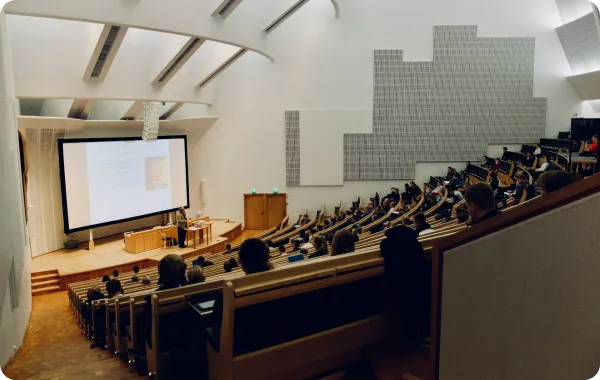Imagine a campus that balances energy efficiency, cost control, and a superior student experience—all while meeting ambitious sustainability goals. For facility managers, this vision isn’t aspirational; it’s essential. But this goal is a complex calculus of budgets, efficiency, and governance, making building automation systems (BAS) a strategic necessity. The technology helps educational institutions tackle energy costs, improve indoor air quality, and meet environmental standards.
Beyond Sustainability: How BAS Is Reshaping Campus Management
Intelligent Building Solutions
Transform your facilities with Automated Logic’s intelligent building automation solutions. Our integrated BAS (Building Automation System) technology delivers real-time data analytics and precise control over HVAC, lighting, and security systems, optimizing both energy efficiency and occupant comfort. Learn more about our solutions.
Challenges for Campus Facility Managers
Managing facilities for college and university campuses is no small feat. Energy costs are an ongoing concern for campuses where HVAC systems, lighting, and specialized equipment in labs draw power almost continually. In dormitories, where the parental mantra, “Turn off the lights,” does not exist, power usage is also a concern. Beyond energy costs, outdated systems account for a host of challenges that demand strategic planning and innovative solutions:
Diverse building needs: Managing a campus with a mix of historic buildings, modern labs, and student housing presents unique challenges. Building automation systems provide the flexibility to tailor solutions to each building type.
Budgetary constraints: Securing funding for upgrades is a challenge in the competitive landscape of higher education, where immediate operational demands often take priority over long-term investments.
Student expectations: Today’s students demand comfortable, tech-enabled spaces that support their learning and well-being. Building automation systems play a key role in creating a positive campus experience.
Data security: Connected systems require robust cybersecurity to protect sensitive campus data. A single breach can compromise student records, research data, and campus operations, making proactive measures critical.
Recent research links ventilation and temperature control to cognitive performance, making indoor air quality (IAQ) a priority. Students in poorly ventilated or uncomfortable spaces are less likely to focus and succeed.
Sustainability adds another layer of complexity, and colleges and universities are expected to lead by example. As a testament to this, environmental, social, and governance (ESG) courses are part of the curriculum in many college classes nowadays. For facility managers, sustainability must extend beyond theory and into practice, requiring them to reduce carbon footprints, comply with environmental standards, and align with broader climate goals.
Why Building Automation Systems are essential
Reducing Energy Costs
Powerful web-based building automation systems provide tools for facility managers to maintain energy efficiency, identify operational problems, and analyze results. For example, they can:
Schedule HVAC operations to match building occupancy and reduce waste.
Adjust lighting and temperature based on time of day or room usage.
Cornell University retrofitted their Biotechnology Building with a modern BAS platform, and the conversion led to annual energy savings of almost $350,000. Reducing ventilation rates in unoccupied labs had a profound impact.
Improving Indoor Air Quality (IAQ)
High-quality indoor air is essential for creating productive learning environments. BAS platforms offer precise ventilation and humidity controls that adapt to fluctuating conditions, with features like real-time air-quality monitoring to allow for proactive management. Ensuring compliance with the American Society of Heating, Refrigeration, and Air-Conditioning Engineers (ASHRAE) standards provides students, faculty, and staff with a healthier campus environment.
In lecture halls or dormitories, a BAS platform with integrated occupancy sensors can adjust airflow based on room occupancy, and subtle changes can maintain comfort without unnecessary energy expenditure. High-density areas like university housing and large classrooms demand this balance.

Supporting Sustainability Goals
Colleges and universities are often tasked with ambitious sustainability targets. Goals include reducing carbon emissions and achieving energy neutrality, and BAS platforms make these goals more attainable. By tracking energy usage, identifying inefficiencies, and automating sustainable practices, tools like energy-reporting dashboards offer actionable insights for campus-wide improvements and illustrate progress against key performance indicators (KPIs).
The University of Virginia’s Darden School of Business used a BAS platform to reduce energy costs by $57,000 over the course of a year. The technology brought the school closer to a broader vision of carbon neutrality. They recommissioned HVAC systems, implemented night setbacks, and automated equipment sequencing, using a centralized platform to manage these efforts.
Best Practices for Schools Adopting BAS
Prioritize high-impact areas: Focus on buildings with high occupancy and energy usage, such as libraries, dormitories, and laboratories, to maximize the impact of your building automation system investment.
Develop a cybersecurity strategy: Ensure your building automation system is protected from cyber threats by implementing robust security measures and protocols.
Conduct a feasibility study: Understand current inefficiencies and assess the ROI for a BAS implementation.
Invest in training: Provide comprehensive training to your facility staff to empower them to effectively manage and utilize the building automation system
Integrate for impact: Combining systems within a single platform enhances efficiency and control. Unified integration allows for streamlined monitoring of HVAC, lighting, and security systems, enabling real-time decision-making and simplifying operations.
Establish KPIs: A clear understanding of performance will help in measuring the success of a BAS implementation.
Get a Smarter Campus for a Better Future
Building automation systems are a necessity for the campus environment because these platforms enable facility managers to meet today’s complex demands. BAS technology pays off with long-term savings and improvements to campus life.
Government
Efficiency
Savings
Building
Automation
About Automated Logic
Automated Logic stands out for their cutting-edge technology. The company also deeply understands what facility managers need to succeed. Their WebCTRL ® building automation software is intuitive, scalable, and built to integrate with existing government facilities.
Automated Logic delivers results by providing intelligent building automation solutions for government buildings. Let us help you balance cost savings with efficiency, comfort, and sustainability. Contact us today to request a demo.

Related articles
©2025 Automated Logic Phoenix. All rights reserved.




